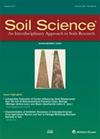Effects of mild alternate wetting and drying irrigation and rice straw application on N2O emissions in rice cultivation
4区 农林科学
Q2 Agricultural and Biological Sciences
引用次数: 1
Abstract
Abstract. The shortage of water resources and the decline in soil organic matter (SOM) are critical limiting factors affecting the improvement in rice productivity, while alternate wetting and drying (AWD) irrigation and recycling application of rice straw (S) are considered favorable mitigation measures. However, the impact of such measures on rice yield and greenhouse gas (GHG) emissions, especially nitrous oxide (N2O) emissions, needs to be further clarified to ensure that agronomic practices save water, conserve soil, and reduce GHG emissions. Therefore, we explored the effects of mild AWD irrigation combined with on-site rice straw recycling on N2O emissions and rice yield through rice pot experiments. This experiment included 2 irrigation methods (continuous flooding (CF) irrigation and mild AWD irrigation), 2 nitrogen (N) application levels (0 and 225 kg N ha−1) and 2 rice straw return levels (0 and 9000 kg ha−1), for a total of 10 treatments, and each treatment had 3 replicates. The 15N-urea and 15N-S were added to the soil. The results showed that N2O emissions were primarily affected by urea application and irrigation methods, with urea application being most important. Compared with CF irrigation, mild AWD irrigation increased cumulative N2O emissions, with an average increase of 28.8 %. In addition, adding rice straw to mild AWD irrigation further stimulated N2O emissions by 18.1 %. Under the condition of urea application, compared with CF irrigation, mild AWD irrigation increased the yield-scaled N2O emissions by 17.9 %, and the addition of rice straw further promoted the yield-scaled N2O emissions under mild AWD irrigation by 17.4 % but reduced the global warming potential (GWP) (methane (CH4) + N2O) by 62.9 %. Under the condition of urea application, compared with CF irrigation, mild AWD irrigation reduced the uptake of soil-derived N and aboveground biomass of rice but did not reduce rice yield. Therefore, mild AWD irrigation combined with rice straw return may be a promising agronomic method to maintain rice yield, reduce GHGs, and protect or improve soil fertility.温和干湿交替灌溉和秸秆施用对水稻栽培N2O排放的影响
摘要水资源短缺和土壤有机质(SOM)下降是影响水稻生产力提高的关键限制因素,而干湿交替灌溉(AWD)和秸秆循环利用(S)被认为是有利的缓解措施。然而,这些措施对水稻产量和温室气体(GHG)排放,特别是一氧化二氮(N2O)排放的影响需要进一步澄清,以确保农业实践节水、保土和减少温室气体排放。因此,我们通过水稻盆栽试验,探索轻度AWD灌溉配合秸秆就地回收对N2O排放和水稻产量的影响。本试验包括2种灌溉方式(连续淹水灌溉和轻度aw灌溉)、2种施氮水平(0和225 kg N ha−1)和2种水稻秸秆还田水平(0和9000 kg ha−1),共10个处理,每个处理3个重复。在土壤中添加15n -尿素和15N-S。结果表明:氮肥施用量和灌溉方式对N2O排放影响最大,其中氮肥施用量影响最大;与CF灌溉相比,轻度AWD灌溉增加了累积N2O排放量,平均增加28.8%。此外,在轻度AWD灌溉中添加稻草进一步刺激了18.1%的N2O排放。在施尿素条件下,与CF灌溉相比,轻度AWD灌溉使产量标度N2O排放量增加了17.9%,秸秆的添加进一步促进了轻度AWD灌溉下产量标度N2O排放量增加了17.4%,但使全球变暖潜能值(GWP)(甲烷(CH4) + N2O)降低了62.9%。在施尿素条件下,与CF灌溉相比,轻度AWD灌溉降低了水稻对土源氮的吸收和地上生物量,但没有降低水稻产量。因此,轻度AWD灌溉配合秸秆还田可能是维持水稻产量、减少温室气体排放、保护或提高土壤肥力的一种有前景的农艺方法。
本文章由计算机程序翻译,如有差异,请以英文原文为准。
求助全文
约1分钟内获得全文
求助全文
来源期刊

Soil Science
农林科学-土壤科学
CiteScore
2.70
自引率
0.00%
发文量
0
审稿时长
4.4 months
期刊介绍:
Cessation.Soil Science satisfies the professional needs of all scientists and laboratory personnel involved in soil and plant research by publishing primary research reports and critical reviews of basic and applied soil science, especially as it relates to soil and plant studies and general environmental soil science.
Each month, Soil Science presents authoritative research articles from an impressive array of discipline: soil chemistry and biochemistry, physics, fertility and nutrition, soil genesis and morphology, soil microbiology and mineralogy. Of immediate relevance to soil scientists-both industrial and academic-this unique publication also has long-range value for agronomists and environmental scientists.
 求助内容:
求助内容: 应助结果提醒方式:
应助结果提醒方式:


